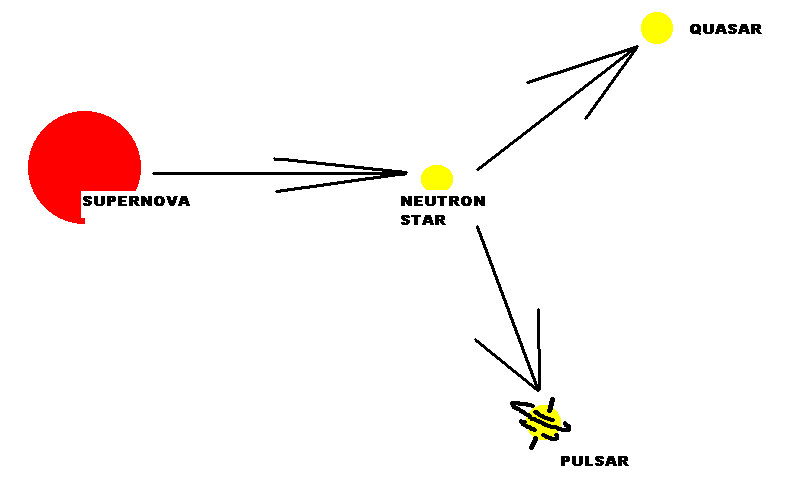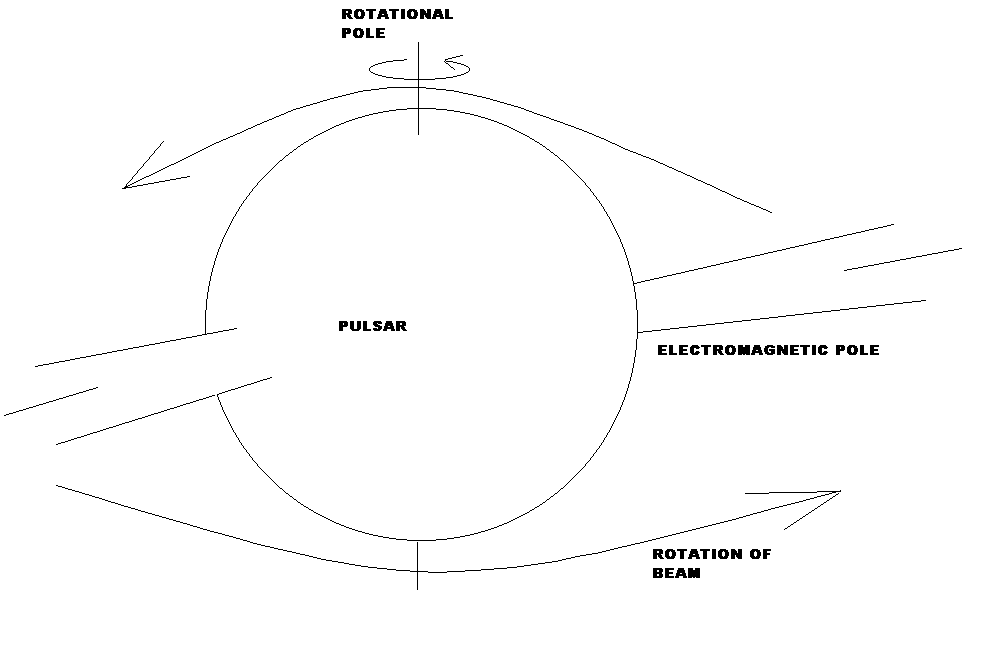
PULSARS

Supernovas cause neutron stars. All the neutrons in the star are squashed into a high-density star. Then there are two things that can happen: 1. The neutron star can become a sphere about the size of earth and transmit radio waves. This is called a quasar. Or 2.The neutron star can be a pulsar. This is a star about the size of earth and it has a fast spin. It also transmits radio waves and every time the pulsarís "pulse" is directed toward the Earth, radio telescopes pick it up.

Astronomers thought there was such a thing as a neutron star before they ever saw one. Toward the end of 1967, a pulsing star was discovered at an observatory in Cambridge England. Jocelyn Bell and Anthony Hewish discovered the first pulsar. First lots of people thought it was LGM or Little Green Men. They thought maybe aliens were trying to communicate with us.
Their second idea was that the pulse was coming from a white dwarf. But even though a white dwarf is very small, it is not packed tightly enough to spin as fast as this pulsar was spinning (like an ice skater, when her arms are out, she spins slower than when her arms are tight against her body). The pulse was coming every 1 and a half seconds. So they decided this must be a neutron star, only a few miles in diameter. A long time ago there was a supernova, and this pulsating neutron star is the remnant.

The Crab Nebula was a supernova seen in 1054 A.D. It is now a huge cloud of expanding gases, which give off energy, including light and radio waves. In 1968, a pulsing sound was heard 30 times a second coming from the Crab Nebula. In January 1969, astronomers in Arizona found a light flashing 30 times a second from the Crab Nebula. These pulses were coming from the pulsar, a neutron star, in the center of the Crab Nebula. This pulsar is the star remnant of a Type II supernova. This pulsar is spinning very, very fast, but every day it slows down just a tiny bit. Actually it slows down a fraction of a second each century. Itís the energy being released as it slows down that makes the light, radio waves, and X-rays.
A pulsar has a very strong electromagnetic field. This field from the Crab Nebula pulsar sends a narrow beam of radio waves. As the pulsar spins, this beam aims at the Earth 30 times a second, kind of like a lighthouse flashing light. That is because the pulsar spins 30 times a second. So the pulsar spins on its rotational poles, and the pulses are sent out from its magnetic poles.

Astronomers think there have been millions of supernovas. Some have disappeared, but since there are lots of gas clouds in the universe, they think these are from supernovas. So that means there should be lots of neutron stars in the universe. And that means there should be lots of pulsars in the universe, too. But astronomers have only identified 706 pulsars. That could be because they are too far away for us to find, or because they have used up too much energy and donít pulse strong enough for us to find. Or maybe when a pulsar pulses, if the Earth is not in line with the beam, we canít pick it up.
Some astronomers are studying the cloud where the SN 1987A exploded. In January 1998 scientists at NASAís Goddard Space Flight Centre announced that there is a pulsar in LMC. They can tell that the star remnant is spinning 60 times a second, the fastest known pulsar.
The Crab Nebula and the SN 1987A were both Type II supernovas.